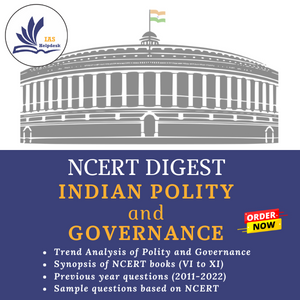Part 4 - Newspaper Terms Simplified for IAS Prelims
Description
Newspaper Terms
Simplified for IAS Prelims
Part 4
1.
Kedarnath
·
Built by - Adi Shankarcharya
·
Deity – Lord Shiva
·
Location - Garhwal Himalayan range near the Mandakini
river.
·
Mandakini is tributary of the Alaknanda River, emerges
from Chorabari glacier and runs between Rudraprayag and Sonprayag.
·
Temple is open between April to November
· In winter the diety is carried down to Ukhimath.
2.
Shumang Leela
·
It is a traditional form of theatre in Manipur.
·
The roles of female artists are all played by male
actors, called Nupi shabis
· Theme: focus on the issues of moral values, unity and integrity
3.
Mohenjodaro
·
Built around 2500 BCE, it is an archaeological site in
the province of Sindh
·
Rediscovered by Rakhal Das Banerji in 1922 and was
recognized as a UNESCO World Heritage site in 1980.
·
It had meticulous urban planning, architecture, road plan
with rectilinear buildings and channeled sanitization.
· It also had a huge well that served as a public pool to bathe - the Great Bath; and the Great Granary.
4.
Operation Polo
·
Operation Polo was the code name for the police
action against the Princely State of Hyderabad in September 1948 by the newly
Independent republic of India. The Indian Army marched into Hyderabad following
the outbreak of hostilities, overwhelming the Hyderabadi military and annexed
Hyderabad into the Indian Union.
· The Centre has decided to mark Hyderabad State Liberation Day on 17th September.
5.
Sri Adi
Shankaracharya
·
Indian philosopher and theologian known for ‘Advaita
Vedanta’ and ‘Dashanami Sampradaya’.
· Main Disciples of Adi Shankara: Padmapada, Totakacharya,
Hastamalaka, and Suresvara; each headed one math (monastery) established by Adi
Shankara. Monastries had been established at Dwarka, Joshimath, Puri and
Sringeri.
·
He wrote commentaries on religious texts such as Brahma
Sutras, Upanishads and Bhagavad Gita. E.g., Brahmasutrabhasya, is the oldest
surviving commentary on ‘Brahma Sutra’.
·
He also wrote ‘Upadesasahasri’.
· Advaita Vedanta states
that all reality and everything in the experienced world has its root
in Brahman, which is unchanging Consciousness. To Advaitins, there is no
duality between a Creator and the created universe.
·
Significance of teachings in present
scenario:
®
overcoming Avidya (ignorance or incorrect knowledge)
through Vidya (knowledge), Shravana (careful listening), Manana (thinking or
contemplating on the teaching) and Nididhyasana (mediating on the teaching).
®
True knowledge liberates an individual from worldly
pleasures or materialism. It can help in reducing corruption and other
malpractices
® Reinvigorating Spiritualism over materialism
6.
Temple
Architecture of Hoysala
·
Vesara style Temple
·
Location: Chennakesava at Belur (dedicated to Krishna),
Hoysaleswara at Halebid (dedicated to Shiva) and Kesava at Somnathapura
(dedicated to Vishnu)
·
Plan of these temples starts looking like a star, and is
thus known as a stellate plan.
·
Made up of soapstone
·
Double building with a large hall for the mandapa to
facilitate music and dance.
·
Follows the Shaivism tradition, but includes themes from
Vaishnavism and Shaktism, too, along with images from Jainism.
·
The sculptures inside the temple depict scenes from the
Ramayana, the Mahabharata and the Bhagavata Purana.
· The ‘Sacred Ensembles of the Hoysala’ have been on UNESCO‘s Tentative List since April 15, 2014.
7.
Convention
for the Safeguarding of the Intangible Cultural Heritage
·
The “intangible cultural heritage” means the practices,
representations, expressions, knowledge, skills – as well as the instruments,
objects, artefacts and cultural spaces associated therewith – that communities,
groups and, in some cases, individuals recognize as part of their cultural
heritage.
·
Preserving living traditions that are transmitted from
generation to generation is the cornerstone of the 2003 UNESCO Convention for
the Safeguarding of the Intangible Cultural Heritage.
· India has been a signatory to the Convention.
8.
Traditional
Indian Textiles
·
Traditional Indian textiles can be divided into:
®
Embroidered textiles (Phulakri, chikankari),
®
Resist dyed textiles (Bandhani, Ikat),
®
Printed textiles (Kalamkari , Bagru prints) and
®
Hand-woven textiles (Banaras Brocades, Kashmir Shawls)
etc.
·
Significance
®
Represents Culture of the region
®
Create jobs and preventing rural to urban migration.
®
contributes around 3% to the GDP of the country.
®
opening of international markets for artisan communities
and development of rural tourism.
·
Issues
®
Unorganised sector, low wages, long working hours etc.
®
quality of products is not at an acceptable level to be
exported
®
Artisans are unable to build a loyal customer base
®
financial shortage
®
unable to compete with the increased competition from
mills
·
Initiatives taken to promote Traditional craft
®
National
Handicraft Development Programme (NHDP): To create a globally competitive Handicrafts
Sector and provide sustainable livelihood opportunities to artisans through
innovative products designs, improvement in product quality, introduction of
modern technology, branding & marketing.
®
Comprehensive
Handicrafts Cluster Development Scheme (CHCDS): To scale up
infrastructural and production chain at Handicrafts clusters across country
which have remained unorganized.
®
Ambedkar
Hastshilp Vikas Yojna (AHVY): To mobilise artisans into self-help groups
and societies with agenda of facilitating bulk production and economies in
procurement of raw materials.
®
Handicrafts
Mega Cluster Mission (HMCM): To provide adequate infrastructural support
for improved quality and productivity, to enable access of artisans to a larger
market segment, both domestic and international.
®
Marketing
Support and Services Scheme: It provides interventions for domestic
marketing events to artisans, such as providing financial assistance for
organising or participating in marketing events in India.
9.
New Tribes in
STs list
·
Hatti tribe in Trans-Giri area of Himachal Pradesh,
Narikoravan and Kurivikkaran hill tribes of Tamil Nadu and Binjhia in
Chhattisgarh, were newly added to list.
·
Hattis are
close-knit community who take their name from their traditional occupation of
selling home-grown crops, vegetables, meat, and wool etc.
·
Narikoravan (jackal
catchers) and Kuruvikaras (bird eaters) are nomadic tribal communities.
·
Binjhia, ethnic group
found in Odisha and Jharkhand, have rich heritage of tradition and culture.

